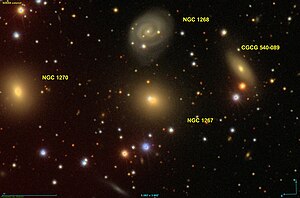NGC 1267
| Galaxy NGC 1267 |
|
|---|---|

|
|
| AladinLite | |
| Constellation | Perseus |
|
Position equinox : J2000.0 , epoch : J2000.0 |
|
| Right ascension | 03 h 18 m 44.9 s |
| declination | + 41 ° 28 ′ 04 ″ |
| Appearance | |
| Morphological type | E + |
| Brightness (visual) | 13.1 mag |
| Brightness (B-band) | 14.1 mag |
| Angular expansion | 1.1 ′ × 0.9 ′ |
| Position angle | 30 ° |
| Surface brightness | 13.2 mag / arcmin² |
| Physical data | |
| Affiliation | Abell 426 |
| Redshift | 0.016875 ± 0.000223 |
| Radial velocity | (5059 ± 67) km / s |
|
Stroke distance v rad / H 0 |
(231 ± 16) x 10 6 ly (70.7 ± 5.0) Mpc |
| history | |
| discovery | Heinrich d'Arrest |
| Discovery date | February 14, 1863 |
| Catalog names | |
| NGC 1267 • UGC 2657 • PGC 12331 • CGCG 540-092 • MCG + 07-07-055 • 2MASX J03184497 + 4128041 • GALEX ASC J031844.91 + 412803.3 • LDCE 224 NED180 | |
NGC 1267 one elliptical galaxy from the Hubble type E2 in the constellation Perseus in the northern sky . It is an estimated 231 million light years from the Milky Way , has a diameter of about 75,000 ly, and is a member of the Perseus Cluster Abell 426 . In the same area of the sky are u. a. the galaxies NGC 1268 , NGC 1270 , NGC 1271 , NGC 1272 .
The object was discovered by Heinrich d'Arrest on February 14, 1863 .
Web links
Commons : NGC 1267 - collection of images, videos, and audio files
